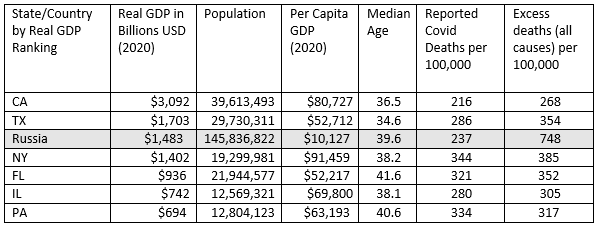We have written about Ukraine and Russia. Here are the links to the prior pieces:
“Ukraine,” https://www.cumber.com/market-commentary/ukraine (Jan. 24, 2022)
“Ukraine!” https://www.cumber.com/market-commentary/ukraine-0 (Feb. 24, 2022)
“Russia – In Perspective Economically,” https://www.cumber.com/market-commentary/russia-perspective-economically (Feb. 25, 2022)
Armchair generals who never wore a uniform & armchair psychiatrists (into Putin’s mind?) are all over TV. Okay; that’s how we live today. We can’t do much about that except to flip to Turner Classic Movies. Or we can get serious with data and research.

The G7 alliance of nations and their allies are engaged in a global economic war. It is being fought with finance. In just one week, the interest rate on a long term Russian government bond has gone from single digits to 40%; the Russian stock market has collapsed and is closed. The per capita income of the average Russian is now about $7000 if we translate the ruble into dollars. Compare that number with the charts you will see below.
In Europe, Russia, Belarus, and Ukraine, there is a ground war making news every minute. Less publicly, the economic war is being waged at high intensity every second. When Switzerland lays aside its neutrality and joins the EU in imposing sanctions on Russia, that is a big item. When a Russian oligarch moves his yacht to the Maldives because that is where he will try to hide and avoid extradition, that is a small item. BTW, the Russian I’m referring to is worth about $25 billion and the global finance war is after him.
Here's chart 1. We show the GDP of Kansas and compare it with pre-war Ukraine and Belarus. The real GDP of Kansas is the closest of any US state to the real GDP of Ukraine, though Ukraine has a population 15 times larger. The takeaway? Ukraine and Belarus are very poor countries, and there is little middle-class stability. That is why Kansas, (a grain state, in part), is compared here with Ukraine (a grain country, in part). Kansas, with its much higher GDP per capita, is far more stable and prosperous. Notice that Kansas is younger than the other two countries.

Let’s get to the bad actor. Chart 2 shows Russia, compared to several large US states.

Note Russia’s relative position with regard to real GDP and real GDP per capita, compared to US states. That’s pre-war. The Russian per capita GDP in US dollar terms has dropped 30% and is falling. Economically, Russia was a relatively minor player and now is in a drastically weakened position. Global economic and finance warfare is being waged with a speed and ferocity unprecedented in history. The counterattack mounted against Russia is very real and damaging. It is not as visible as missiles and tanks.
We have listed the median age of the population in each jurisdiction for a reason. Notice that they are all fairly close. We want to show that age-related demographic differences are not big factors driving differences in the other numbers.
We are also showing official Covid deaths and the estimates of excess deaths. Why Covid? And why excess deaths?
Because the excess death data (from The Economist) shows that Russia has sustained more than twice the pandemic demographic shock that Florida and Texas did. And almost twice the shock that New York (where Covid hit hard early) did.
A pandemic results in more excess deaths from all causes than recorded deaths from a pandemic disease. But the bigger the relative data gap, the less the credibility of the capitols of those countries or states. (Interestingly, the CDC’s estimate for excess deaths from all causes in Pennsylvania falls short of the Johns Hopkins Covid dashboard’s number for confirmed Covid deaths in that state. We don’t have an explanation for that discrepancy. Perhaps the CDC does.)
Life expectancy declined in all jurisdictions because of the pandemic, and nowhere more than in Russia, though the US was not far behind (“COVID-19 Cuts Life Expectancy in Dozens of Countries,” https://jamanetwork.com/journals/jama/fullarticle/2788128).
In a Nov. 23, 2021, story in The New Yorker, author Joshua Yaffa reports:
“By the beginning of November, Russia had experienced an excess mortality of around eight hundred thousand people since the start of the covid-19 pandemic. According to calculations by Dmitry Kobak and Ariel Karlinsky, statisticians who have tracked global covid-related deaths since last year, Russia has now surpassed the world’s previous leader, the United States, in terms of total excess deaths, and trails only Peru and Bulgaria in terms of per-capita losses.” (“Why Russia Hasn’t Cracked Down on COVID-19,” https://www.newyorker.com/news/dispatch/why-russia-hasnt-cracked-down-on-covid-19)
For every dead person, there are between 6 and 20 Long Covid cases of temporary or partial or permanent disability. Multiply the excess death number by the Long Covid case range to estimate an impact of Long Covid. Russia almost certainly faces a huge burden from Long Covid, based on its excess deaths.
Finally, war spreads disease. That has been true throughout history. This true right now in these three countries.
Russia has been slammed by Covid. This reality might, in part, explain some of Putin's desperate decisions. He is a dictator of a failing state; that makes him extremely dangerous. Just how dangerous remains to be seen. We strongly recommend that readers take five minutes to read Fiona Hill’s interview at Politico, “‘Yes, He Would’: Fiona Hill on Putin and Nukes,” https://www.politico.com/news/magazine/2022/02/28/world-war-iii-already-there-00012340. Hat tip to those who sent this piece our way, including Paul Schulte and Marc Suffern.
Two final points: First, in our US Equity ETF portfolio we remain overweight the aerospace-defense sector, and we have a heavy weight in the American bank and financials sector; banks are a frontline weapon in this global war.
We expect the Federal Reserve will do its patriotic duty to support the United States, which is engaged in this global war of finance. That is what the Fed has done since its creation prior to World War 1. We wish the selfish actions of politicians would ease up for a minute so that the full complement of Federal Reserve Governors gets immediately confirmed and the Fed doesn’t have to operate a financial system in a wartime setting with one arm tied behind its back. Shame on any partisan politician (Democrat or Republican) who puts party power ahead of the national interest.
Lastly, many years ago as a second lieutenant in the US Army I fired a 50-caliber tripod-mounted machine gun at a target 600 yards away. It was an awesomely powerful weapon. I had to see the target to shoot at it (which means the target could see me to shoot back).
As I wrap up this commentary, I watch a neighbor launch a drone at twilight, and it flies all over Sarasota Bay. It darts around at dizzying speeds. It has “eyes,” too, and, if it were armed, its range is much longer than the 50-caliber machine gun. I can see it maneuver because it has flashing red and green warning lights. But military drones don’t have the flashing lights. Warfare today is a lot more than just a long column of tanks on a road; it is also drones overhead — small, elusive targets striking from above — and it’s more than aircraft carriers and nuclear-tipped ICBMs. Today, war is powerful cyber-attacks and financial attacks that aren’t visible but are deadly and damaging.
That’s where we are. We are in a global war.
For additional background and able analysis of Russia’s economic position in the global economy, please see also Bob Eisenbeis’s February 25 commentary, “Russia – In Perspective Economically,” https://www.cumber.com/market-commentary/russia-perspective-economically.
Be safe.
David R. Kotok
Chairman & Chief Investment Officer
Email | Bio
Links to other websites or electronic media controlled or offered by Third-Parties (non-affiliates of Cumberland Advisors) are provided only as a reference and courtesy to our users. Cumberland Advisors has no control over such websites, does not recommend or endorse any opinions, ideas, products, information, or content of such sites, and makes no warranties as to the accuracy, completeness, reliability or suitability of their content. Cumberland Advisors hereby disclaims liability for any information, materials, products or services posted or offered at any of the Third-Party websites. The Third-Party may have a privacy and/or security policy different from that of Cumberland Advisors. Therefore, please refer to the specific privacy and security policies of the Third-Party when accessing their websites.
Cumberland Advisors Market Commentaries offer insights and analysis on upcoming, important economic issues that potentially impact global financial markets. Our team shares their thinking on global economic developments, market news and other factors that often influence investment opportunities and strategies.

